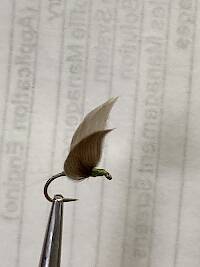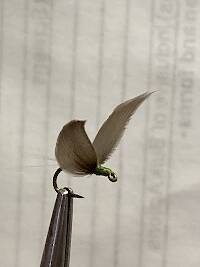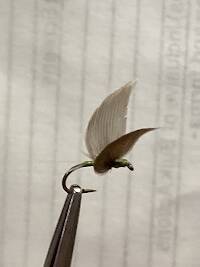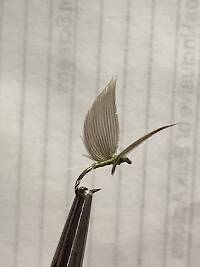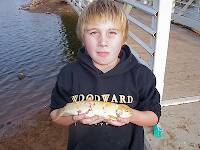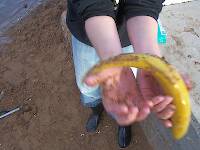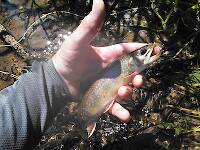
Salmonflies
Pteronarcys californica
The giant Salmonflies of the Western mountains are legendary for their proclivity to elicit consistent dry-fly action and ferocious strikes.
Featured on the forum

It's only barely visible in one of my pictures, but I confirmed under the microscope that this one has a prosternal horn and the antennae are mid-way between the eyes and front of the head capsule.
I'm calling this one Pycnopsyche, but it's a bit perplexing. It seems to key definitively to at least Couplet 8 of the Key to Genera of Limnephilidae Larvae. That narrows it down to three genera, and the case seems wrong for the other two. The case looks right for Pycnopsyche, and it fits one of the key characteristics: "Abdominal sternum II without chloride epithelium and abdominal segment IX with only single seta on each side of dorsal sclerite." However, the characteristic "metanotal sa1 sclerites not fused, although often contiguous" does not seem to fit well. Those sclerites sure look fused to me, although I can make out a thin groove in the touching halves in the anterior half under the microscope. Perhaps this is a regional variation.
The only species of Pycnopsyche documented in Washington state is Pycnopsyche guttifera, and the colors and markings around the head of this specimen seem to match very well a specimen of that species from Massachusetts on Bugguide. So I am placing it in that species for now.
Whatever species this is, I photographed another specimen of seemingly the same species from the same spot a couple months later.
I'm calling this one Pycnopsyche, but it's a bit perplexing. It seems to key definitively to at least Couplet 8 of the Key to Genera of Limnephilidae Larvae. That narrows it down to three genera, and the case seems wrong for the other two. The case looks right for Pycnopsyche, and it fits one of the key characteristics: "Abdominal sternum II without chloride epithelium and abdominal segment IX with only single seta on each side of dorsal sclerite." However, the characteristic "metanotal sa1 sclerites not fused, although often contiguous" does not seem to fit well. Those sclerites sure look fused to me, although I can make out a thin groove in the touching halves in the anterior half under the microscope. Perhaps this is a regional variation.
The only species of Pycnopsyche documented in Washington state is Pycnopsyche guttifera, and the colors and markings around the head of this specimen seem to match very well a specimen of that species from Massachusetts on Bugguide. So I am placing it in that species for now.
Whatever species this is, I photographed another specimen of seemingly the same species from the same spot a couple months later.

Troutnut is a project started in 2003 by salmonid ecologist Jason "Troutnut" Neuswanger to help anglers and
fly tyers unabashedly embrace the entomological side of the sport. Learn more about Troutnut or
support the project for an enhanced experience here.
Martinlf on Jul 20, 2008July 20th, 2008, 5:17 am EDT
This may prove helpful to anyone who dyes biots. For years I've struggled to get an even dye job on goose or turkey biots, typically tying a stem in a loose overhand knot to get them to fan out. Today I used a rubber band to bind one end of a stem of biots to the middle of a pencil, wrapped the biot stem up the shaft, fanning out the biots parachute style, then used a rubber band to secure the other end of the stem to the top of the pencil. The fanned out biots took the dye evenly and were easy to rinse. The pencil provided a nice handle to avoid fishing around in the dye bath with hemostats to find the biot stem. To dry the stem straight for easy storage, I undid the spiral, smoothed the biots down into their original configuration, stretched out the stem straight, and again rubber banded the ends to the pencil and left it to dry.
"He spread them a yard and a half. 'And every one that got away is this big.'"
--Fred Chappell
--Fred Chappell
Wbranch on Jul 20, 2008July 20th, 2008, 6:58 am EDT
Louis,
Why do you bother dying biots when so many colors are readily available alreadty dyed? Rumpf lists sixteen different color turkey biots.
Why do you bother dying biots when so many colors are readily available alreadty dyed? Rumpf lists sixteen different color turkey biots.
Catskill fly fisher for fifty-five years.
Martinlf on Jul 20, 2008July 20th, 2008, 1:33 pm EDT
Matt,
Sometimes when I'm tying I don't have exactly what I want, so I keep some white biots on hand and some Rit and dye them myself rather than ordering or running to a fly shop. It puts the materials I want at hand quickly, and with shipping or gas prices what they are it may also be cost effective. I also enjoy messing with it. Sometimes I want an odd color such as a teal green for the Tully's emerald caddis hatch, so I'll dye biots that color. Last year I dyed some biots a brighter yellow than I had on hand for sulphur emergers. What I had would probably have worked, but I get obsessive at times, I must admit.
Sometimes when I'm tying I don't have exactly what I want, so I keep some white biots on hand and some Rit and dye them myself rather than ordering or running to a fly shop. It puts the materials I want at hand quickly, and with shipping or gas prices what they are it may also be cost effective. I also enjoy messing with it. Sometimes I want an odd color such as a teal green for the Tully's emerald caddis hatch, so I'll dye biots that color. Last year I dyed some biots a brighter yellow than I had on hand for sulphur emergers. What I had would probably have worked, but I get obsessive at times, I must admit.
"He spread them a yard and a half. 'And every one that got away is this big.'"
--Fred Chappell
--Fred Chappell
Wbranch on Jul 20, 2008July 20th, 2008, 7:26 pm EDT
"but I get obsessive at times, I must admit."
Ya think? Borger mentions in his "Color System" that as long as you are within one or two shades of the ideal color you are in good shape.
Ya think? Borger mentions in his "Color System" that as long as you are within one or two shades of the ideal color you are in good shape.
Catskill fly fisher for fifty-five years.
JAD on Jul 21, 2008July 21st, 2008, 12:38 am EDT
Hi
We fisherman are a odd breed, confidence is sometimes as important as color. Keep up the good work,I might need some teal green .
I like the pencil trick
John
They fasten red (crimson red) wool around a hook, and fix onto the wool two feathers which grow under a cock’s wattles, and which in colour are like wax.
Radcliffe's Fishing from the Earliest Times,
Martinlf on Jul 21, 2008July 21st, 2008, 2:02 am EDT
Matt,
Guilty as charged, but John makes a good point. We do what we must to believe, then success follows. Sometimes. I had dyed biots for that emerger pattern that worked on the West Branch, and without it (and your guidance) I would possibly have gotten beat up that evening. As it turned out it was my best fishing ever on the upper West Branch. It's a mysterious process by which each of us finds the right fly, the right drift, and the right fish.
Guilty as charged, but John makes a good point. We do what we must to believe, then success follows. Sometimes. I had dyed biots for that emerger pattern that worked on the West Branch, and without it (and your guidance) I would possibly have gotten beat up that evening. As it turned out it was my best fishing ever on the upper West Branch. It's a mysterious process by which each of us finds the right fly, the right drift, and the right fish.
"He spread them a yard and a half. 'And every one that got away is this big.'"
--Fred Chappell
--Fred Chappell
PAmike on Apr 28, 2011April 28th, 2011, 8:22 pm EDT
Ever try to bleach and dye wild ones?
Taxon on Apr 28, 2011April 28th, 2011, 9:10 pm EDT
PAmike on Apr 29, 2011April 29th, 2011, 3:38 am EDT
Well wild turkeys are bi colored. Farm raised turkeys are all white. If I were to dye the feathers from a wild turkey would I not have to bleach them first,then dye them?
DrMartin
Posts: 6
Posts: 6
DrMartin on Apr 30, 2011April 30th, 2011, 8:40 pm EDT
I've tried bleaching and dying wild turkey feathers. Not for tying but for fletching on arrows. The barring will still be visable even after bleaching.
David Martin
PAmike on Apr 30, 2011April 30th, 2011, 9:05 pm EDT
That's what I thought. Thanks, Mike
Oldredbarn on May 2, 2011May 2nd, 2011, 8:37 am EDT
but I get obsessive at times
Louis,
No, no, no! Lets you and I just call it play...I still have, passed on to me from an old fishing buddy, his recipes for hand mixed dubbing for each bug we may run in to up on the Au Sable...I have a pile of beaver in rainbow colors and in the middle of winter I'm hand blending dubbing...50% color "A", 20% color "B" etc...It feels good to do somehow and therefore just part of the deal. Once I've picked out all the guard hairs it's a beautiful fluff of soft dubbing...When I first started tying my mentor and I sat in his basement with the hockey game on and if there were any errant guard hairs remaining in my batch or it wasn't fluffed up to perfection I didn't pass the test.
Its only appears obsessional to an outside observer...It's all relative...Right?! :)
Spence
"Even when my best efforts fail it's a satisfying challenge, and that, after all, is the essence of fly fishing." -Chauncy Lively
"Envy not the man who lives beside the river, but the man the river flows through." Joseph T Heywood
"Envy not the man who lives beside the river, but the man the river flows through." Joseph T Heywood
Sayfu
Posts: 560
Posts: 560
Sayfu on Oct 17, 2011October 17th, 2011, 7:16 am EDT
I avoid dying, but sure wish goose biots would take a Pantone pen!!!!! Darn plastic non accepting things! I use the naturals a lot, and really like the abdomen effect you get. Had the naturals work super for BWO's when the color was anything but what I wanted.
Quick Reply
Related Discussions
Topic
Replies
Last Reply
6
Feb 16, 2021
by Martinlf
by Martinlf
4
Jun 5, 2007
by Wiflyfisher
by Wiflyfisher
16
Jan 14, 2009
by Martinlf
by Martinlf








